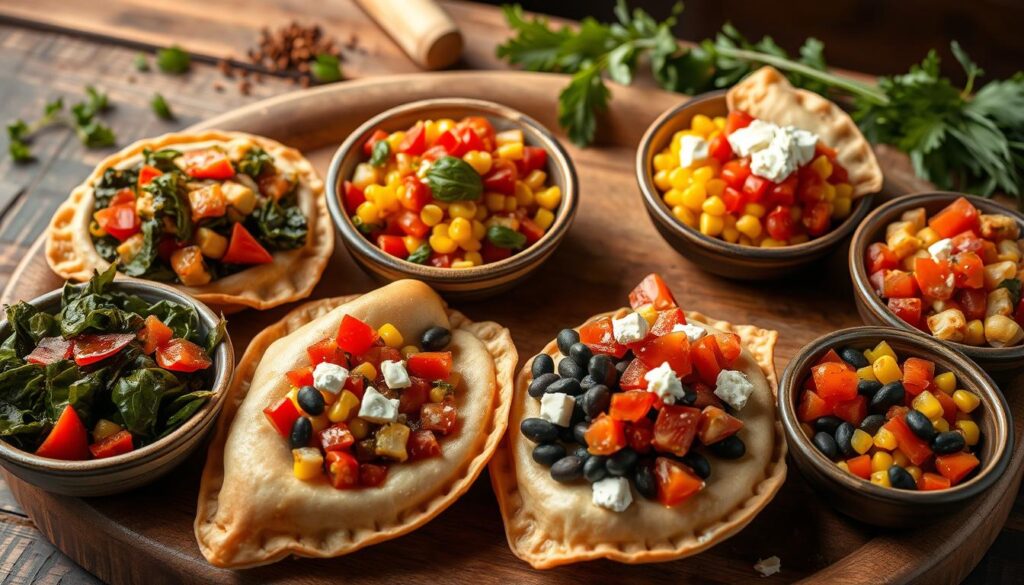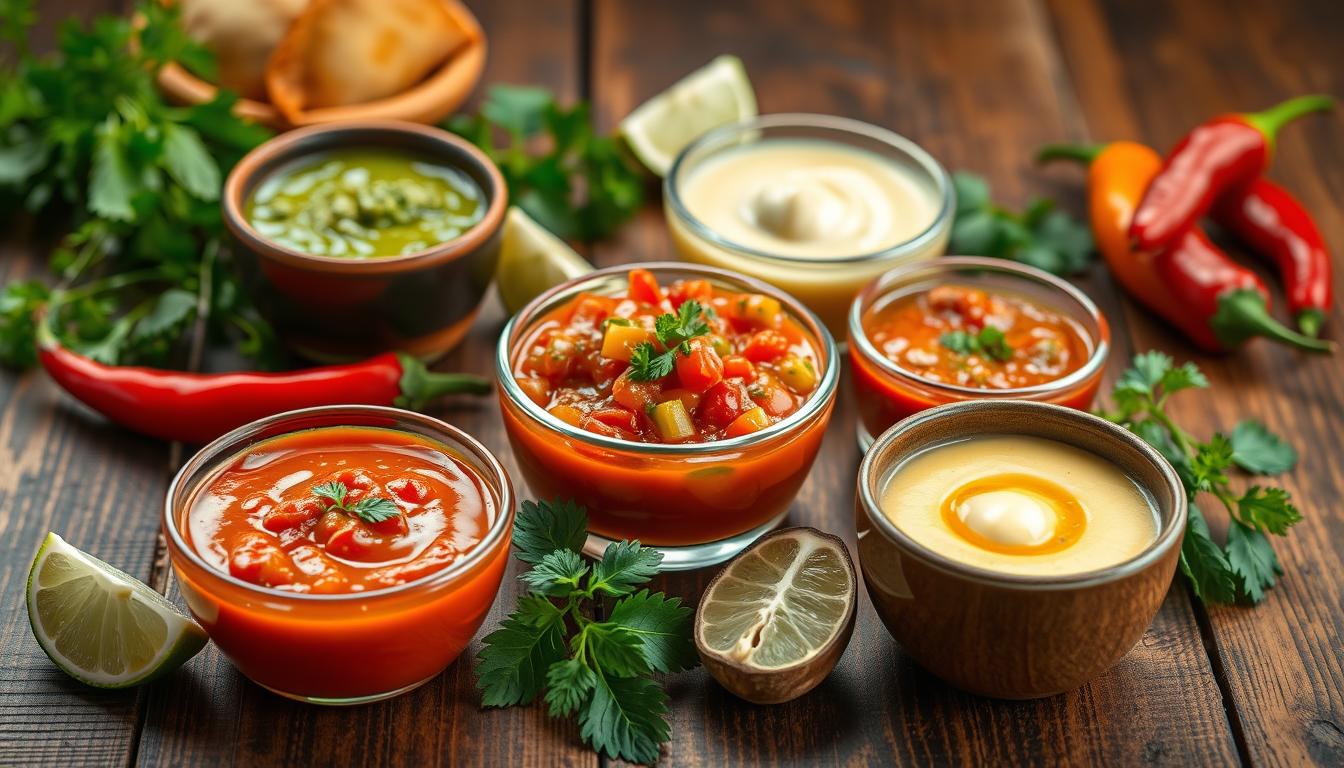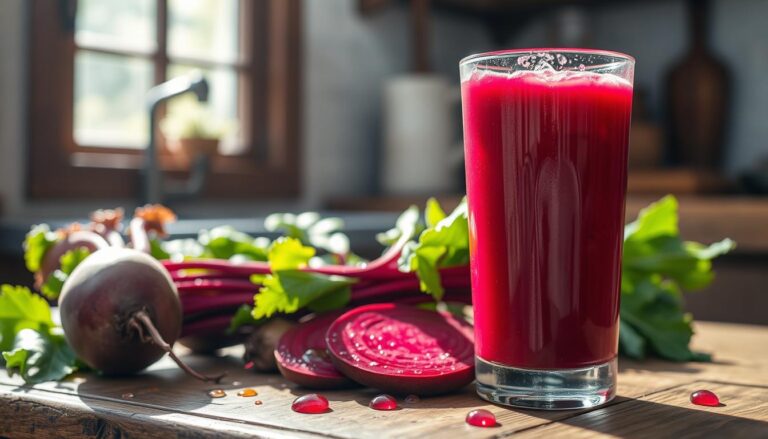Easy Homemade Empanada Recipe: 1Step-by-Step Guide
Easy Homemade Empanada Recipe: Step-by-Step Guide
Start a fun cooking journey with us as we dive into making real, homemade empanadas. This guide will show you how to make these tasty Latin American treats from the start. You’ll learn the key steps to make perfect empanadas, no matter if you’re a pro or just starting out.(Recipe)

Learn how to make the flaky crust and the tasty fillings. Discover the history and different types of empanadas. Then, follow our easy steps to make your own empanadas. You’ll be able to wow your loved ones with the amazing smell and taste of these delicious pastries.(Recipe)
Key Takeaways
- Discover the art of making authentic, homemade empanadas from scratch
- Explore the rich history and regional variations of this beloved Latin American dish
- Learn the essential techniques for creating the perfect empanada dough and fillings
- Dive into the step-by-step instructions for folding and baking delicious empanadas
- Unlock the secrets to achieving the perfect empanada texture and flavor every time
Introduction to Traditional Empanadas
Empanadas are a favorite in Latin American cuisine. They have a long history across the region’s diverse cultures. These tasty pastries are filled with various ingredients and are loved in Argentina, Colombia, and Chile.(Recipe)
History of Latin American Empanadas
The story of empanadas starts in the Iberian Peninsula. They were popular there during the Middle Ages. Spanish and Portuguese colonizers brought them to the Americas, making empanadas a part of local foods.(Recipe)
Later, Latin American chefs and home cooks made their own versions. They tried different fillings and methods, creating many regional empanadas.(Recipe)
Regional Variations and Styles
- In Argentina, empanadas are baked. They have a flaky crust and fillings like beef or chicken.
- Colombian empanadas are fried. They’re filled with beef, potatoes, and peas, and served with aji sauce.(Recipe)
- The Chilean empanada is shaped like a half-moon. It can be baked or fried, with fillings like beef and onions or seafood.(Recipe)
These variations show the diversity of Latin American cuisine. They highlight the creativity of local cooks in making empanadas their own.(Recipe)
“Empanadas are more than just a snack – they’re a taste of the vibrant culture and history of Latin America.”(Recipe)
Essential Ingredients for Perfect Empanada Dough
Making the perfect empanada dough is key to delicious empanadas. Whether you’re using beef or vegetarian fillings, the dough quality matters. Let’s explore the must-have ingredients for the best empanada dough recipe.(Recipe)
Flour is the main ingredient in empanada dough. Recipes often mix all-purpose flour with cornmeal for a flaky texture. A 3:1 ratio of all-purpose flour to cornmeal is a good starting point.(Recipe)
Fat is also crucial for the dough. Shortening, lard, or a mix of both are used for tenderness. Make sure these fats are cold before adding them to the dough.
| Ingredient | Purpose | Typical Ratio |
|---|---|---|
| All-purpose flour | Provides structure and stability | 3 parts |
| Cornmeal | Adds a delicate, flaky texture | 1 part |
| Shortening or lard | Tenderizes the dough and adds richness | 1 part fat to 4 parts flour |
| Water | Binds the dough together | Adjust as needed for desired consistency |
Water is the last key ingredient. It’s added to the flour and fat mix to hold the dough together. The amount of water needed can change based on the climate and humidity. So, add it slowly until the dough feels just right.
With the right balance of these ingredients, you’ll make perfect, flaky empanada shells. Your homemade empanadas will be a hit!
How to Make Empanada Recipe: Basic Steps
Making homemade empanadas is a fun cooking journey. Learning the basic steps helps you make tasty empanada dough and put together these loved Latin American treats. Here are the key steps to make the best empanada recipe.
Mixing and Kneading Techniques
Start by mixing the dry ingredients for your empanada dough in a big bowl. Add the wet ingredients, like water or egg, until a rough dough forms. Then, knead the dough for 5-7 minutes until it’s smooth and stretchy.
This step is important. It makes your homemade empanadas have the right texture.
Dough Resting Tips
- After kneading, cover the empanada dough with a damp cloth or plastic wrap. Let it rest for at least 30 minutes. This makes the dough easier to work with.
- For even better results, chill the dough in the fridge for up to 24 hours. This improves the dough’s texture and taste.
Rolling and Cutting Methods
When you’re ready to make your empanadas, lightly flour your surface and rolling pin. Split the dough into equal parts and roll each into a thin circle. Use a cookie cutter or sharp knife to cut out circles for your homemade empanadas.
With these basic techniques, you’re ready to make delicious, homemade empanadas. Enjoy the process and the tasty results you’ll get.
Classic Beef Empanada Filling Recipe
Making the perfect beef empanada filling is key to a true Latin American taste. This recipe is for both experienced cooks and beginners. It shows how to make a delicious meat empanada filling that will make your taste buds happy.
Choosing the right ingredients is the first step. Pick a lean ground beef for the best texture and taste. Mix it with spices like cumin, paprika, and oregano for a rich flavor.
To make the filling even better, cook onions, garlic, and bell peppers until they’re soft and sweet. This step adds a lot of flavor and texture.
Now, let’s make the filling come alive. Add diced tomatoes, red wine vinegar, salt, and pepper. Let it simmer until the beef is fully cooked and the flavors mix well.
With the beef empanada filling ready, you’re almost there. Feel free to try new things like different spices, veggies, or even raisins or olives. It’s all about what you like.
Whether you’re having a party or just want a taste of Latin America, this beef empanada filling will make your empanadas amazing. Your guests will love them, or you’ll enjoy them all by yourself.
Popular Chicken Empanada Variations
Chicken empanadas are a favorite in Latin America, known for their variety of tastes and local touches. They mix tender chicken with spices and put it in a flaky crust. From Peru’s aji amarillo to Mexico’s lime, these pastries show off the continent’s rich food culture.
Seasoning and Spice Combinations
The secret to great chicken empanadas is in the mix of spices. Here are some top choices:
- Cumin, paprika, and oregano – a classic mix that adds warmth and depth.
- Aji amarillo, garlic, and cilantro – a bold, Peruvian flavor with a kick.
- Lime, chili powder, and coriander – a zesty, Mexican taste that brightens the filling.
Preparing the Perfect Filling Consistency
Getting the filling just right is an art. It should be moist and full of flavor, but not too wet or dry. Here are some tips:
- Simmer the chicken in broth until it’s tender and juicy.
- Add a bit of cornstarch or flour to help the filling stick together.
- Find the right balance of chicken to other ingredients like onions and peppers.
By trying different spice mixes and mastering filling texture, you can make amazing chicken empanadas. These dishes celebrate the rich tastes of Latin America.
Vegetarian Empanada Filling Options
Looking for a meatless twist on empanadas? There are many tasty vegetarian fillings to try. From cheese and veggies to plant-based options, you can make empanadas that are both flavorful and satisfying.
Cheese and Veggie Empanadas
A mix of cheese and sautéed veggies is a favorite. Combine sautéed onions, bell peppers, mushrooms, and spinach. Add garlic, cumin, and chili powder, then mix in queso fresco or Oaxaca cheese.
Potato and Corn Empanadas
Try roasted or mashed potatoes with sweet corn and spices for a comforting filling. Add a sprinkle of cotija cheese for a tangy touch.
Black Bean and Sweet Potato Empanadas
Combine black beans with roasted sweet potatoes for a tasty filling. Season with cumin, chili powder, and oregano for extra flavor.
Quinoa and Vegetable Empanadas
For a protein-rich option, use cooked quinoa, sautéed veggies, and spices. This filling works well with various cheeses or plant-based proteins.
Butternut Squash and Goat Cheese Empanadas
Roasted butternut squash and creamy goat cheese make a sweet and savory filling. Top with chopped walnuts or pecans for extra texture.
Creating tasty vegetarian empanadas is all about bold flavors and fresh ingredients. Try different fillings to find your favorite vegetarian empanada recipe.

Mastering the Empanada Folding Technique
Making the perfect empanada is like an art. The folding technique is very important. It helps you get that crescent shape and a tight seal, whether you’re making traditional or new flavors.
Different Sealing Methods
There are many ways to fold empanadas, but the main goal is a tight seal. Here are some popular methods:
- The classic media luna or half-moon fold, where the dough is folded over and the edges are crimped with a fork.
- The empanada de mano, or hand-folded empanada, which involves folding the dough over the filling and pinching the edges together.
- The repulgue technique, where the dough is folded over and the edges are crimped and twisted to create a decorative pattern.
Decorative Edge Patterns
Once you get the basic folding down, you can get creative with edge patterns. Here are some ways to make your empanadas look great:
- The cordón or “rope” edge, where you twist the dough to create a braided appearance.
- The rayitas or “little lines” pattern, made by pressing the tines of a fork along the edges.
- The ondas or “waves” edge, which involves gently crimping the dough to create a wavy pattern.
With a bit of practice, you’ll be folding and sealing empanadas like a pro. Your creations will be both tasty and beautiful.
Baking vs. Frying: Cooking Methods Compared
Choosing between baking and frying empanadas can change how they taste. Each method has its own benefits and things to think about. Let’s look at the good and bad of each to help you pick the best way to cook your empanadas.
Baking Empanadas: A Healthier Option
Baking empanadas is a healthier choice than frying. It uses less fat and oil, making it better for you. Baked empanadas are light and flaky, with a golden crust that’s as tasty as fried ones.
Frying Empanadas: Achieving Crispy Perfection
Frying empanadas makes them crispy and indulgent. This method seals in flavors and adds a crunchy texture. But, it also adds more fat and calories.
Whether to bake or fry empanadas depends on what you like and your health goals. Both ways can make delicious empanadas. Try both to see which one you prefer.
“Empanadas are the perfect canvas for both baking and frying, allowing you to explore different textures and flavors.”
Traditional Empanada Dipping Sauces
Make your homemade empanadas even better with traditional dipping sauces. These sauces not only match the savory fillings but also bring a unique taste to your meal.
Chimichurri Sauce Recipe
Chimichurri comes from Argentina and is a lively green sauce. It adds a zesty flavor to empanadas. To make it, mix fresh parsley, garlic, olive oil, red wine vinegar, and a bit of crushed red pepper flakes. This sauce is perfectly balanced and will make everyone want more.
Spicy Dipping Options
- Venezuelan Guasacaca: A creamy avocado sauce with a spicy kick, great for Venezuelan empanadas.
- Peruvian Aji Verde: This green sauce, made with aji amarillo peppers, cilantro, and lime, is perfect for baked or fried empanadas.
- Colombian Aji Picante: From Colombia, this sauce combines roasted tomatoes, onions, and chili peppers for a bold taste.
Try these traditional dipping sauces to find your new favorite flavors. They will take your homemade empanadas to the next level, whether they’re Argentine, Venezuelan, or Latin American-inspired.

Make-Ahead and Storage Tips
Homemade empanadas are best when you prepare and store them right. They’re perfect for parties or quick snacks. Here are some tips to keep your empanadas fresh and tasty.
Freezing for Future Enjoyment
Homemade empanadas freeze really well. Cool them down after baking. Then, put them on a baking sheet and freeze.
Once they’re frozen, move them to an airtight container or bag. This way, you can reheat them whenever you want.
Storing in the Refrigerator
If you don’t freeze them, you can keep them in the fridge for 3-4 days. Cool the empanadas down after baking. Then, put them in a container or bag.
Reheat them in the oven or microwave when you’re ready to eat.
Reheating Tips
- For frozen empanadas, preheat your oven to 350°F (175°C). Place the empanadas on a baking sheet and bake for 15-20 minutes, or until heated through and crispy.
- For refrigerated empanadas, you can reheat them in the oven at 350°F (175°C) for 10-15 minutes, or in the microwave for 30-60 seconds, depending on the size.
Remember, gentle handling and careful reheating are key. Enjoy your homemade empanadas at their best, whether they’re fresh or made ahead.
Common Mistakes to Avoid When Making Empanadas
Making the perfect empanada is a fun challenge. But, it’s key to avoid common mistakes for great results. Whether you’re an experienced baker or a home cook, knowing these pitfalls can improve your empanada skills. You’ll be able to serve dishes that taste like they came from a restaurant.
Troubleshooting Guide
One big problem is when the dough tears or cracks while assembling. This usually happens if you overwork the dough or don’t let it rest enough. To fix this, knead the dough just until it’s ready, and chill it in the fridge for at least 30 minutes before filling.
Another issue is leaky empanadas, often due to a wet or poorly seasoned filling. To solve this, dry any veggies or meats well before adding them. Also, taste and adjust the filling’s seasoning to keep it balanced and prevent a soggy bottom.
Expert Tips for Success
- Use a sturdy, non-stick empanada maker or press for perfectly sealed empanadas.
- Try different baking methods, like baking part of the empanada before frying, for the best texture.
- Brush the empanadas with egg wash or melted butter before baking for a golden crust.
By using these how to make empanada recipe and empanada baking tips, you’ll make authentic empanada recipes that wow everyone. Dive into the world of empanada-making and enjoy the tasty fruits of your labor!
Serving Suggestions and Presentation Ideas
Make your homemade spanish empanada recipe stand out with creative serving ideas. Learn how to present your traditional empanada recipe in a way that’s both authentic and eye-catching. This will let you dive into the rich traditions of latin american cuisine.
There are many ways to serve empanadas. For a laid-back setting, place them on a wooden board or platter with colorful sauces and garnishes. For a more elegant setting, serve each empanada on its own plate, decorated with matching elements.
- Pair empanadas with Latin American favorites like chimichurri sauce, spicy salsa, or creamy avocado dip.
- Top empanadas with fresh herbs, sliced limes, or paprika for a striking look.
- Try a “build-your-own” empanada station for a fun, interactive experience.
Think about the empanada’s shape and size when plating. Arrange them in a way that looks good, like a circle or a pyramid. You can also play with different folding styles to make unique shapes. This will make your traditional empanada recipe even more appealing.
The secret to a memorable latin american cuisine experience is embracing the bold flavors and cultural heritage. By presenting your spanish empanada recipe with flair, you’ll wow your guests. They’ll feel like they’re in the heart of Latin American culinary wonders.
Adapting Recipes for Dietary Restrictions
More people want different food options, and empanada lovers with special diets are happy. You can make empanadas without meat, gluten, or dairy and still enjoy great taste and texture.
Vegetarian Empanada Recipes
Looking for tasty vegetarian empanada recipes? You’ve got lots of choices. Swap out beef or chicken for sweet potatoes, mushrooms, or a mix of black beans, corn, and bell peppers. You can also change the empanada dough recipe to use plant-based fats and skip animal products.
Gluten-Free Empanadas
Gluten-free folks can still enjoy flaky empanadas. Use rice flour, almond flour, or gluten-free blends instead of regular flour. These empanada filling options pair well with gluten-free dough, making for a tasty treat.
Dairy-Free Adaptations
Need a dairy-free empanada? Swap butter or milk for coconut oil, almond milk, or oat milk in the empanada dough recipe. For fillings, skip the cheese or use non-dairy cheese.
With a bit of creativity, everyone can enjoy empanadas, no matter their diet. Try new ingredients and methods to make delicious, homemade empanadas that fit your dietary needs.
Wine and Beverage Pairings
Enjoying empanadas is even better with the right drink. Latin American cuisine has many drinks that match the flavors of these tasty pastries.
Traditional Latin American Drinks
Latin American foods often come with special drinks. These drinks show the culture of the area. For example, Argentinian mate tea and Mexican horchata are refreshing and flavorful.
Modern Pairing Suggestions
Empanadas also pair well with new drinks. A full-bodied malbec wine from Argentina goes great with beef empanadas. For lighter options, try a crisp Spanish albariño wine with chicken or veggie empanadas.
FAQ
What are the key ingredients needed to make the perfect empanada dough?
To make empanada dough, you need all-purpose flour, shortening or butter, water, and a bit of salt. The exact amounts and types can change based on the region. But together, they create a crust that’s tender and flaky.
Can I make empanada dough in advance?
Yes, you can make empanada dough ahead of time. It can stay in the fridge for up to 3 days or be frozen for months. Just thaw it in the fridge overnight and let it warm up before you roll and fill it.
What are some popular filling options for empanadas?
Empanadas can have many fillings, both savory and sweet. You can use seasoned ground beef, shredded chicken, pork, cheese, veggies, or even fruit like apple or guava. You can pick what you like best.
How do I properly seal and crimp the empanada dough?
Sealing the dough is key to keep the filling inside. Brush the edges with water or egg wash. Then, fold the dough over and crimp the edges with a fork or your fingers. This makes a nice seal.
Should I bake or fry my empanadas?
Both baking and frying can make great empanadas. Baked ones have a flakier crust, while fried ones are crisp and golden. It’s up to you and what recipe you’re using.
What are some traditional Latin American dipping sauces for empanadas?
Empanadas often come with dipping sauces. You might find chimichurri from Argentina, ají from Colombia, or salsa criolla from Latin America. These add flavor.
How can I adapt empanada recipes for dietary restrictions?
Empanadas can be made for different diets. For gluten-free, use gluten-free flour or cornmeal. For dairy-free, use plant-based fats and skip the cheese. It’s easy to make them fit your needs.







